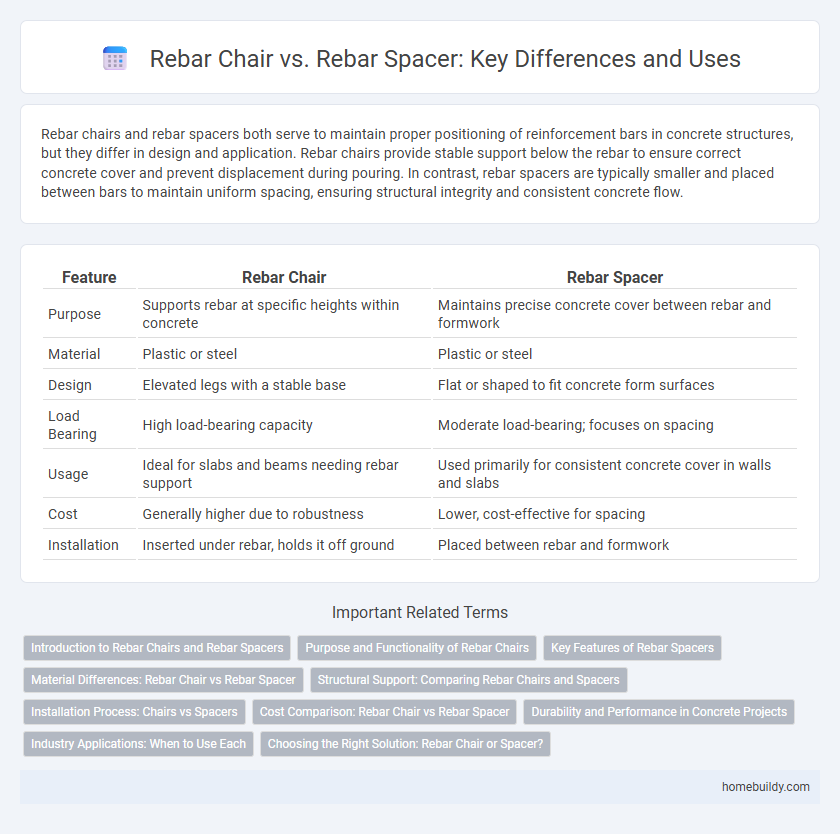Rebar chairs and rebar spacers both serve to maintain proper positioning of reinforcement bars in concrete structures, but they differ in design and application. Rebar chairs provide stable support below the rebar to ensure correct concrete cover and prevent displacement during pouring. In contrast, rebar spacers are typically smaller and placed between bars to maintain uniform spacing, ensuring structural integrity and consistent concrete flow.
Table of Comparison
| Feature | Rebar Chair | Rebar Spacer |
|---|---|---|
| Purpose | Supports rebar at specific heights within concrete | Maintains precise concrete cover between rebar and formwork |
| Material | Plastic or steel | Plastic or steel |
| Design | Elevated legs with a stable base | Flat or shaped to fit concrete form surfaces |
| Load Bearing | High load-bearing capacity | Moderate load-bearing; focuses on spacing |
| Usage | Ideal for slabs and beams needing rebar support | Used primarily for consistent concrete cover in walls and slabs |
| Cost | Generally higher due to robustness | Lower, cost-effective for spacing |
| Installation | Inserted under rebar, holds it off ground | Placed between rebar and formwork |
Introduction to Rebar Chairs and Rebar Spacers
Rebar chairs and rebar spacers are essential concrete accessories used to maintain the position and alignment of reinforcing bars during construction. Rebar chairs support the rebar grid at the correct height to ensure proper concrete coverage, preventing corrosion and structural weaknesses. Rebar spacers create a precise gap between the reinforcing bars and formwork, ensuring consistent concrete thickness and enhancing the durability of the reinforced concrete structure.
Purpose and Functionality of Rebar Chairs
Rebar chairs are designed to support and elevate rebar off the ground, ensuring uniform concrete cover and structural integrity by maintaining proper positioning during the concrete pour. Unlike rebar spacers, which primarily keep rebar tied together at consistent distances, rebar chairs provide stable vertical support to prevent steel bars from sagging or shifting. Their purpose is critical in achieving accurate reinforcement placement, which enhances the durability and load-bearing capacity of concrete structures.
Key Features of Rebar Spacers
Rebar spacers ensure precise concrete cover by maintaining consistent gaps between rebar and the formwork, preventing corrosion and enhancing structural durability. Made from durable plastic or concrete, these spacers resist crushing under heavy loads and are available in various shapes and sizes to fit different reinforcement designs. Their corrosion resistance and load-bearing capacity distinguish them from rebar chairs, which primarily support vertical positioning of rebar rather than controlling cover thickness.
Material Differences: Rebar Chair vs Rebar Spacer
Rebar chairs are typically made from high-strength plastic or steel designed to support rebar at specific heights without deforming under load, ensuring precise concrete cover. Rebar spacers, often composed of plastic or concrete, are engineered to maintain consistent spacing between rebar and formwork, preventing displacement during concrete pouring. The material choice impacts durability, load-bearing capacity, and suitability for various construction environments.
Structural Support: Comparing Rebar Chairs and Spacers
Rebar chairs provide reliable vertical support by elevating rebar to maintain precise cover, ensuring consistent concrete thickness and structural integrity. Rebar spacers, while also supporting rebar placement, primarily prevent horizontal displacement during the concrete pour, offering less elevation control compared to chairs. The choice between rebar chairs and spacers directly impacts load distribution, concrete bonding, and overall durability in reinforced concrete structures.
Installation Process: Chairs vs Spacers
Rebar chairs are installed by placing them beneath the rebar to hold it at a precise height during concrete pouring, ensuring consistent cover and structural integrity. Rebar spacers, on the other hand, are positioned between rebars or between rebar and formwork to maintain accurate spacing and prevent movement during the concrete pour. The installation process for chairs often involves lifting the rebar, while spacers are clipped or tied directly onto the rebar, making spacers quicker to apply in tight or congested areas.
Cost Comparison: Rebar Chair vs Rebar Spacer
Rebar chairs generally cost more than rebar spacers due to their robust design and ability to support heavier loads during concrete placement. Rebar spacers offer a more economical option for maintaining proper rebar positioning, especially in lighter-duty applications. Selecting between the two depends on project requirements, as chair costs range from $0.30 to $1.50 per unit, while spacers typically cost between $0.10 and $0.50.
Durability and Performance in Concrete Projects
Rebar chairs and rebar spacers both ensure proper positioning of reinforcement bars, but rebar chairs typically offer greater durability due to their rigid structure and resistance to concrete pressures during pouring. Rebar chairs provide superior performance by maintaining consistent concrete cover, reducing the risk of corrosion and structural weaknesses over time. Rebar spacers, while effective for lighter applications, may compromise long-term durability in heavy-duty concrete projects due to less robust material composition.
Industry Applications: When to Use Each
Rebar chairs are ideal for elevating reinforcement bars in concrete slabs and floors to ensure proper concrete cover and structural integrity. Rebar spacers are used primarily to maintain consistent spacing between bars in walls, columns, and beams, preventing displacement during concrete pouring. Industry professionals choose rebar chairs for horizontal applications and rebar spacers for vertical or complex formwork to optimize stability and compliance with construction standards.
Choosing the Right Solution: Rebar Chair or Spacer?
Selecting the appropriate reinforcement support between a rebar chair and a rebar spacer depends on the specific concrete structure requirements and site conditions. Rebar chairs provide stable elevation for rebar, especially in slabs and beams, ensuring consistent concrete cover and preventing displacement during pouring. Rebar spacers are ideal for securing rebar to formwork, maintaining accurate spacing from the surface and reducing the risk of corrosion, making them crucial for structural integrity.
Rebar Chair vs Rebar Spacer Infographic

 homebuildy.com
homebuildy.com